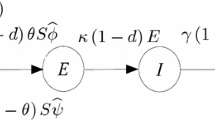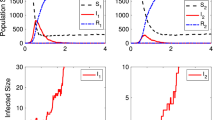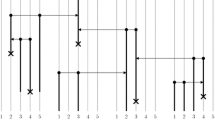Abstract
This paper considers the time to extinction for a stochastic epidemic model of SEIR form without replacement of susceptibles. It first shows how previous rigorous results can be heuristically explained in terms of the more transparent dynamics of an approximating deterministic system. The model is then extended to include a host population structured into patches, with weak nearest-neighbour mixing of infection. It is shown, by considering the approximating deterministic system, that the expected time to extinction in a population of n + 1 patches each of size N is of the form a log N + bn, provided that N > N c where N c is a critical patch size below which transits are unlikely to occur. This corresponds to the simple decomposition of the time of an epidemic into the time it takes to spread through one patch plus the time it takes to transit to each of n successive patches. Expressions for this threshold and the coefficients of the time to extinction are given in terms of the transmission parameters of infection and the coupling strength between patches. These expressions are compared with numerical results using parameters relevant to a study of phocine distemper virus in North Sea seals, and the agreement is found to be good for large and small N. In the region when N ≈ N c , where transits may or may not occur, interesting transitional behaviour is seen, leading to a non-monotonicity of the extinction time as a function of N.
Similar content being viewed by others
References
Abramowitz, M. and I. A. Stegun (1970). A Handbook of Mathematical Functions, 9th edn, New York: Dover.
Bailey, N. T. J. (1975). The Mathematical Theory of Infectious Disease and its Applications, London: Griffin.
Barbour, A. D. (1975). The duration of the closed stochastic epidemic. Biometrika, 62, 477–482.
Barrett, T., M. Blixenkrone-Møller, M. Domingo, T. Harder, P. Have, B. Liess, C. Örvell, A. D. M. E. Osterhaus, J. Plana and V. Svansson (1992). Round table on morbilliviruses in marine mammals. Vet. Microbiol. 33, 287–295.
Bartlett, M. S. (1956). Deterministic and stochastic models for recurrent epidemics, in Proceedings of the Third Berkeley Symposium on Mathematical Statistics and Probability, J. Neyman (Ed.), Berkeley: University of California Press, pp. 81–109.
Cox, D. R. and D. Oakes (1984). Analysis of Survival Data, London: Chapman and Hall.
de Jong, M. C. M., O. Diekmann and J. A. P. Heesterbeek (1995). How does transmission of infection depend on population size? in Epidemic Models, their Structure and Relation to Data, D. Mollison (Ed.), Cambridge: Cambridge University Press, pp. 84–94.
de Koeijer, A., O. Diekmann and P. Reijnders (1998). Modelling the spread of Phocine Distemper Virus (PDV) among Harbor seals. Bulletin of Mathematical Biology, in press.
Diekmann, O., M. C. M. de Jong, A. A. de Koeijer and P. Reijnders (1996a). The force of infection in populations of varying size: a modelling problem. J. Biol. Syst. 2, 519–529.
Diekmann, O., A. A. de Koeijer and J. A. J. Metz (1996b). On the final size of epidemics within herds. Can. Appl. Math. Quart. 4, 21–30.
Grenfell, B. T., B. M. Bolker and A. Kleczkowski (1995a). Seasonality and extinction in chaotic metapopulations. Proc. Roy. Soc. Lond. B259, 97–103.
Grenfell B. T., B. M. Bolker and A. Kleczkowski (1995b). Seasonality, demography, and the dynamics of measles in developed countries, in Epidemic Models, their Structure and Relation to Data, D. Mollison (Ed.), Cambridge: Cambridge University Press, pp. 248–270.
Hanski, I. and M. Gilpin (1991). Metapopulation dynamics: brief history and conceptual domain. Biol. J. Linnean Soc., 42, 3–16.
Heide-Jørgenson, M. P. and T. Härkönen (1992). Epizootiology of the seal disease in the eastern North Sea. J. Appl. Ecol. 29, 99–107.
Heide-Jørgenson, M. P., T. Härkönen, R. Dietz and P. M. Thompson (1992). Retrospective of the 1988 European seal epizootic. Dis. Aquatic Organisms, 13, 37–62.
Mollison, D. (1985). Sensitivity analysis of simple endemic models, in Population Dynamics of Rabies in Wildlife, P. H. Bacon (Ed.), London: Academic Press, pp. 223–234.
Mollison, D. (Ed.) (1995). Epidemic Models, their Structure and Relation to Data, Cambridge: Cambridge University Press.
Picard, P. and C. Lefèvre (1993). Distribution of the final state and severity of epidemics with fatal risk. Stoch. Proc. Appl., 48, 277–294.
Ridler-Rowe, C. J. (1967). On a stochastic model of an epidemic. J. Appl. Prob. 4, 19–33.
Svensson, Å. (1995). On the asymptotic size and duration of a class of epidemic models. J. Appl. Prob. 32, 11–24.
Swinton, J., F. Tuyttens, D. Macdonald, D. J. Nokes, C. L. Cheeseman and R. Clifton-Hadley (1997). A comparison of fertility control and lethal control of bovine tuberculosis in badgers: the impact of perturbation induced transmission. Phil. Trans. Roy. Soc. Lond. B352, 619–631.
Swinton, J., J. Harwood, B. Grenfell and C. Gilligan (1998). Persistence thresholds for phocine distemper virus infection in harbour seal metapopulations. J. Anim. Ecol., 67, 54–68.
Thompson, P. M. (1989). The Common Seal, Aylesbury: Shire Natural History.
Author information
Authors and Affiliations
Rights and permissions
About this article
Cite this article
Swinton, J. Extinction times and phase transitions for spatially structured closed epidemics. Bull. Math. Biol. 60, 215–230 (1998). https://doi.org/10.1006/bulm.1997.0014
Received:
Accepted:
Issue Date:
DOI: https://doi.org/10.1006/bulm.1997.0014




